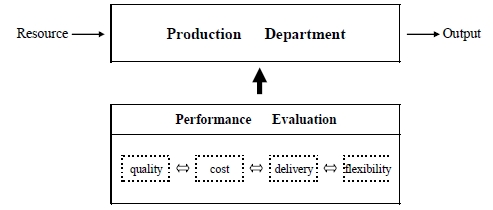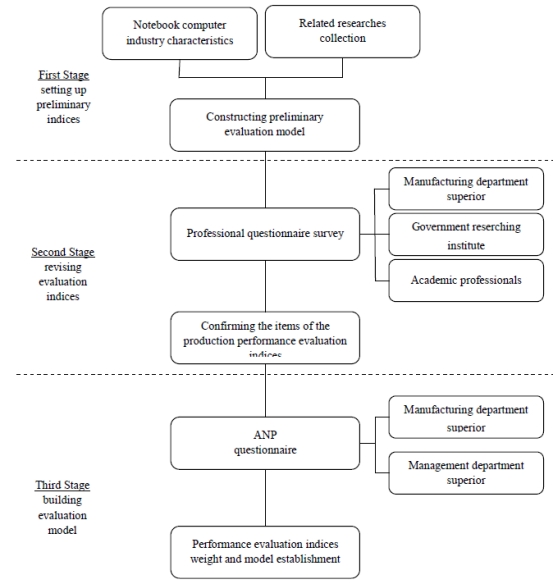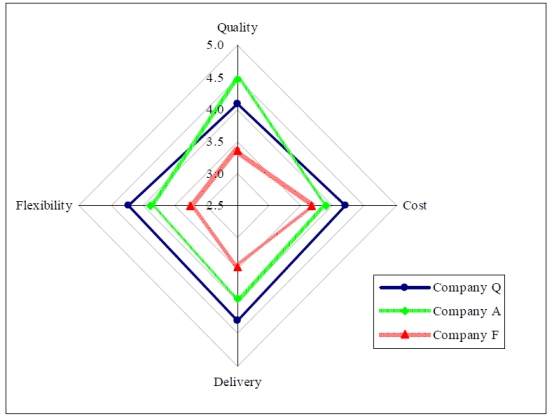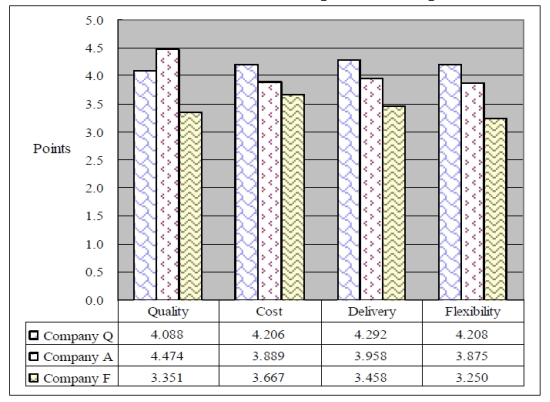资料来源:Industrial Engineering and Engineering Management, 2009. IEEM 2009. IEEE International Conference on
A Manufacturing Performance Evaluation Model for Notebook Computer Manufacturers
R. H. Huang 1, C. L. Yang2, H. L. Shih1
1 Graduate Institute of management, Fu Jen Catholic University, Taipei, Taiwan
2 Department of Business Administration, Fu Jen Catholic University, Taipei, Taiwan
Abstract - The notebook computer industry is closely connected to global economies. The major notebook computer companies have cut their prices to increase market share in a highly competitive marketplace. The OEM manufacturers have sharply reduce profit to generate orders. The key to survival for ODM/OEM manufacturers is to improve production performance; however, production improvements require a complete production performance evaluation model and accurate evaluation indices. Such a model will help businesses exploit resources, improve production performance to meet customer needs and reach operational goals. This study divides the performance evaluation model for production of notebook computers into three stages: construction of preliminary evaluation indices; revision of evaluation indices; and, construction of an evaluation model. Evaluation indices are based on quality, cost, delivery and flexibility. These characteristics are used to develop 12 strategic themes and 69 performance evaluation indices. Preliminary evaluation indices are constructed using the Delphi method. Opinions from industrial, governmental and academic professionals are collected and analyzed. The Analytical Network Process (ANP) developed by Saaty is applied to weight indices for each characteristic. Finally, the complete model is deployed to evaluate the performance of the case company and verify model practicability.
Keywords - notebook computer, production performance evaluation, analysis network process
I. INTRODUCTION
Throughout the history of the notebook computer industry, brand companies have focused on brand marketing. Other activities, such as concept development, manufacturing, logistics, and post-sale service, are left to OEM/ODM notebook computer manufacturers. The characteristics of the notebook computer manufacturing industry are short product lifecycle and technology intensive production, often doing OEM/ODM with low profit and the big ones becomes bigger.
Production performance evaluation has been studied extensively [1-17]. These studies utilize different viewpoints and reference values.
II. EVALUATION MODEL CONSTRUCTION
This study refers to related studies and characteristics of the notebook computer industry to construct preliminary evaluation indices for quality, cost, delivery and flexibility. Figure 1 shows the framework of the production performance evaluation model.

Figure. 1 Framework of notebook computer manufacturer performance management model
The research framework of this study has three stages (Fig. 2). The model is constructed by collecting related references, analyzing industrial characteristics, establishing preliminary indices, conducting a questionnaire survey, revising evaluation indices and deploying an analytical network process (ANP) questionnaire. Questionnaires are analyzed and indices weights are calculated. At this stage, the model is complete.
III. PRELIMINARY EVALUATION INDICES
The preliminary evaluation indices are as follows: 1) Quality: To survive in a highly competitive marketplace and achieve business continuity, product quality is vital. This study combines theory and practice in notebook computer manufacturing industry to summarize four strategic themes for quality: process quality management; preventive mechanism, employee intelligence and customer service. These four strategic themes have 23 performance evaluation indices.
2) Cost: Most global notebook computer markets are controlled by major brands. Controlling production costs and reducing expenditures are necessary steps for OEM/ODM manufacturers. Thus, this study develops four strategic cost themes: human resource planning; facility deployment; materials management; and, operational procedures. These strategic themes have 27 performance evaluation indices.
3) Delivery: Time and speed are essential to success. To deliver superior products to customers in a timely fashion, internal production scheduling and outbound are vital. This research uses two strategic delivery themes—scheduling ability and delivery level, and 10 delivery performance evaluation indices.
4) Flexibility: To meet diversified customer needs in a rapidly changing market, extraordinary manufacturer flexibility is indispensible. This study constructs two strategic flexibility themes—adaptability and customization—and 9 flexibility performance evaluation indices.

Figure.2 Research framework
IV. REVISED EVALUATION INDICES
To confirm the adaptability of the evaluation model after constructing the preliminary evaluation indices, this study separates the professional questionnaire survey into two stages. The preliminary questionnaire is designed to test the fitness of strategic aspects, themes and performance evaluation indices using a two-point scale. Items with >90% applicability are retained. Items with <90% are discarded. Via advice and revisions, the revised questionnaire survey was sent to expert. The revised survey obtains opinions from professionals and completes the revision of performance evaluation indices for the notebook computer manufacturing industry. Survey subjects are from academia, and manufacturing and research-based fields. The survey was sent to three managers with more than five years of experience in each field. Twelve questionnaires were sent and 12 were recovered; the recovery rate was 100%.
IV. BUILDING EVALUATION MODEL
The final evaluation indices are calculated to weight each level and to generate a complete production Figure 5 compares aspect weights. Company Q outperforms companies A and F in cost, delivery and performance model for notebook computer manufacturers. Due to the dependence among each aspect and feedback from indices, the ANP developed by Saaty [18] is applied to calculate weights. The calculation steps are as follows.
Step 1: Define problem solutions and the needed information and knowledge.
Step 2: Construct the production performance evaluation model and ANP framework (Fig. 3). Step 3: Construct the ANP questionnaire survey. Step 4: Build pairwise comparison matrices for each level based on questionnaire results. This includes importance comparisons between two interacting clusters and elements pairwise comparison within the same cluster.
Step 5: Calculate the eigenvector and perform a consistency test.
Step 6: Transform the original pairwise comparison weights into a super-matrix with appropriate weights; the vector sum of each column is 1. Via randomization, a weighted super-matrix is achieved. Multiply the weighted super-matrix to obtain a limiting super-matrix in which each value in the super-matrix converges to a constant value. Thus, the relative weights of each element are achieved.
Step 7: Build a production performance evaluation table for notebook computers with the relative weights of each index (Table 1).
VI. EMPIRICAL RESEARCH
A professional evaluation team empirically evaluates three case companies using a questionnaire survey. Questionnaire responses are on a five-point Likert scale. Based on the weights of indices, the practicability of the evaluation model is verified. Evaluation results are provided for three companies as a reference.
Figure 4 presents a radar chart of overall performance evaluation results for the three companies. The largest area in the chart implies high performance. Company Q had the best performance, followed by companies A and F.

Figure. 4 A, F, Q company overall performance radar chart
flexibility, demonstrating that company Q excels in cost control, delivery and flexibility. Company Q also has the highest overall performance. Although company A has outstanding quality performance, opportunities to improve cost control are still considerable. We recommend that company A enhance human resource planning, facilities deployment, material management and operational procedures. Company F has the poorest at quality and least amount of flexibility. We recommend that company F improve its process quality management, preventive mechanisms, customer service, adaptability and customization to increase overall production performance.

Figure. 5 A, F, Q company actual performance evaluation chart
VII. CONCLUSIONS
This study constructed a production performance evaluation model for notebook computers. Manufacturers can evaluate their current production performance and create future improvement plans by applying this model. Manufacturers can also understand their advantages and shortcomings, and integrate the analytical result with a business strategy to strengthen future competitive advantage.
Overall, the most influential aspect of notebook computer production performance is quality (34.5%). Thus, the first priority is production quality for brand companies choosing OEM/ODM manufacturers.
Consumers also consider quality as their first concern. The second influential aspect is cost (29.6%). In a rapidly changing market, controlling costs with skill and exploiting experience to forecast demand and respond to patterns to achieve high inventory turnover are essential goals for all businesses. The two aspects, contain more than half of all aspects. Controlling these two aspects is key to enhancing overall production performance. Moreover, the third aspect is delivery (20.5%). In a rapidly changing competitive environment, the role of time is considerable. Businesses that master time and speed have a competitive niche. The last aspect is flexibility (15.4%), suggesting that customization is a trend for future notebook computers. The top five indices affecting notebook computer production performance in decreasing order are on time delivery (4.7%), customer complaint rate (4.5%), value generated per person (3.6%), first inspection qualified rate (3.5%) and inventory turnover rate (3.4%). These indices have great value for practical applications.



